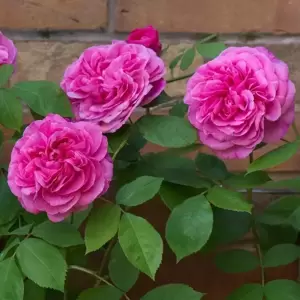Get to know...Roses
Roses come in many shapes and sizes; their versatility makes them a great plant for almost any garden.
Get To Know Roses
With so many different types to choose from, you may want to consider the following when deciding which would be best suited to your space.
- Colour - roses are available in an endless range of colours and shades. Consider what will fit with your colour scheme.
- Scent - do you like the scent of roses? If so, do you prefer musky, or fruity fragrances?
- Location and purpose - this is the big question: where will you put your rose and want do you want it to do?
After you've answered the above-mentioned questions, it's time to choose which type of rose fits your situation best. Cowell's has a fantastic range of various rose types. Let us help you pick the right rose.
Make Your Choice

You can select your favourite rose by colour.
Types of roses
There are several different types of roses, each with its own benefits. See which type of rose is best for you and consider deciding on which rose you're buying.
- Climbing roses: these type of roses grow between 1.5m and 3.5m, they're perfect for trellises, fences, or walls and repeat flowering all summer. Cut faded flowers to stimulate new growth and extend the flowering season.
- Rambling roses: these are vigorous growers reaching 5m to 6m high. They flower in spring and look lovely grown over garden structures, such as sheds and trellises, or in hedges.
- Patio roses: these are smaller varieties that grow compact flowers. These flowers bloom throughout the summer. You can either plant them in containers or directly in the ground.
- Ground cover roses: these types provide a stunning carpet of flowers, spreading to approximately 1.5m wide. You can plant them under deciduous hedges, perennials or small trees.
- Bush and shrub roses: these roses grow between 0.6m and 1.8m high, which makes them perfect for small gardens and balconies. This species includes Hybrid Tea roses (typically scented, large-flowered) and Floribunda roses (smaller, clustered flowers).
- David Austin roses: also called English roses have been the exquisite English rose for 60 years. Check out our range online.
Planting roses tips
Most commonly, roses are sold in containers, although you can also buy bare-root plants.
Tips for planting container-grown roses
- Generally, roses prefer a sunny position where they don't have to compete for water or light. You can plant container-grown roses at any time of the year, as long as the ground is nog frozen or waterlogged.
- Once you've chosen a suitable position, mix a bucket of well-rotted organic matter into the ground to enrich the soil's nutrients. Standard potting soil contains enough nutrients for up to 6 weeks, but if you want to give your rose a fantastic start, we recommend using a fertiliser.
- Dig a hole about twice the width of the plant and the same height as the pot. Scatter in some Rootgrow but don't mix it in - you want to ensure the roots have direct contact with the Rootgrow.
- Plant the rose in the ground ensuring that the rose sits no lower in the ground than it did in the pot. Backfill the plant hole and water the soil around the base thoroughly.
Tips for planting bare-root roses
Bare-root roses are dormant roses and should be planted in cooler months before new growth begins to grow. Bare-root roses are sold without soil around the roots in the dormant season, from November to March. When you buy a bare-root rose, it's important to plant it in the soil as soon as possible, as long as the ground isn't frozen. Bare-root roses will first put energy in growing a strong root system, instead of producing flowers, like potted-grown roses do instantly after planting. Bare-root roses are cheaper because they don't need to ship any soil, which is more space-efficient.

Tips for replacing roses
Please note that if you're replacing an old rose with a new one, you will need to change the soil within a half-metre radius to avoid soil sickness. Roses can get sick of soil that has been used by roses before. Soil sickness means the passing of diseases between plants. Ensure to replace the soil and enrich it with organic matter, before you replace an old rose with a new one. You can buy soil improvers in our webshop.
Planting Roses
.png)
Pruning roses
Main pruning should be done in spring and varies according to the type of rose:
.png)
Rose Care Tips
Roses are relatively low-maintenance plants and will live for years providing beautiful flowers year after year if pruned correctly.
When to prune roses
- Hybrid Tea roses (large-flowered): cut stems back to 10cm-15cm above ground level and remove old wood to make way for younger, more vigorous shoots.
- Floribunda roses (cluster-flowered): cut the most vigorous stems back to 25cm-30cm and less vigorous stems even more - to about 10cm.
- Shrub roses: they need less pruning as they flower on old wood. Carry out light, regular pruning to develop a balance of young and old stems.
- Patio roses: lightly prune by removing twiggy growth and removing any shoots that spoil the desired shape of the plant.
- Climbing roses: remove any really old branches from the base and take flowered shoots back by about two-thirds of their length.
- Rambling roses: remove one in three of the oldest stems entirely. If space is limited, cut stems once they have flowered, otherwise, these can be left to ramble, as the name suggests.
Extra rose care tips
In addition to pruning, roses will benefit from being deadheaded and fed regularly with a high potash feed, such as Tomorite, throughout the flowering season to encourage more blooms. Also, keep an eye out for black spots and mildew, if this occurs, spray with RoseClear and remove any affected leaves.































